 Susan Swartz—From Baldwin to Budapest to Beijing
Susan Swartz—From Baldwin to Budapest to Beijing







 Susan Swartz—From Baldwin to Budapest to Beijing
Susan Swartz—From Baldwin to Budapest to Beijing








What an honor it is to write to you as Edinboro University’s still relatively new president.
I’ve had the pleasure of meeting some of you since I assumed office on July 1 and have appreciated your warm welcome. I look forward to meeting more of you in the coming months.
You may be aware that I like to walk. Not only is it good exercise, it gives me a chance to get to know campus and the students, faculty and staff who live and work here. The campus is quite beautiful, with wellmanicured green space; and Edinboro is a solid place and a great place to call home.
Since my arrival, I have been working with the executive leadership team and other faculty and staff colleagues on establishing priorities for the foreseeable future. First and foremost among those priorities are financial stability and enrollment growth, which are obviously intertwined. Tied to these are related goals of improving recruitment, retention and revenue streams.
I am pleased to report that we saw an 18% increase in our first-year enrollment – 706 for fall 2019 versus 598 last year. The 706 first-time undergraduate students represent the University’s largest incoming class in three years.
Not only are the numbers up, the academic preparedness of first-year students continues to improve. The increased quality is clearly a result of the decision made three years ago by University leadership to up admission criteria. The move was predicated on the belief that better-prepared students would retain better, which means students would be less likely to leave Edinboro with debt, but without a degree. The decision was a wise one.
The average high school grade-point average is 3.55 for the first-year class that entered Edinboro this fall, compared with 3.51 and 3.53 in 2018 and 2017,
respectively. There is clearly reason to celebrate and to congratulate the Admissions staff and all those who played a role in recruitment. The jump in the number and quality of this year’s incoming class is a clear reflection of Edinboro’s perceived value.
Our new students have shown themselves to be a strong and engaged class, and I look forward to the many ways they are sure to enrich our campus community.
That being said, there remains work to do. Our total enrollment is down by 188 (4,646 versus 4,834 in fall 2018), a drop that is significantly lower than what we had projected and dramatically better than the declines of the last two years. We have clearly curbed the downward spiral and are anticipating growth through 2025. That growth can be achieved if we work together and more creatively.
Those who know the University best are in an ideal position to share the Edinboro story and its shared points of pride. I invite you to join with the campus community to ensure Edinboro’s star shines brightly. Ours is a university that has educated students for more than 160 years, providing them with transformational experiences and preparing them to become significant contributors to their families, their communities, the Commonwealth and beyond. I am quite certain that Edinboro will continue this mission for many years to come.
Many thanks! I look forward to partnering with you on this journey.
Guiyou Huang, Ph.D. President, Edinboro University
Guiyou Huang, Ph.D., has logged many miles on walks across the Edinboro campus since July 1, his first day as the University’s president. Not only is it great exercise, it’s also a good way to get to know Edinboro’s 585 acres and the students, faculty and staff that call the space home.

“It’s a beautiful place – one of the prettiest campuses I’ve seen – and a solid place,” said Huang, whose professional path has taken him from China to Texas to Pennsylvania, Michigan, Florida, Vermont and Louisiana. Both he and his wife, Jennifer Yufeng Qian, Ed.D., are happy to have returned “home” to Pennsylvania, the state where they were married, the first of their two children was born, and he became a U.S. citizen.
Former colleagues, staff members and professional mentors said Edinboro has found an excellent leader in Huang, who grew up in China, one of three children of two strong role models. Although his parents lacked formal education, they instilled in their children strong values.
 By Angela Burrows
By Angela Burrows
Those values – hard work, the importance of social justice, humility, integrity and respect for others – are readily apparent to those who know Huang, a former English professor. They are values that make for a good leader, said Richard Schneider, Ph.D., president of Norwich University in Vermont, where Huang spent six and a half years as senior vice president for academic affairs and dean of the faculty before moving to Louisiana State University at Alexandria (LSUA). He served for two and a half years as LSUA’s chancellor prior to his appointment at Edinboro.
“He’s a gentle spirit and a good listener, but he also knows what right looks like and has the courage to say, ‘This is not good enough,’ said Schneider, whom Huang counts among his mentors.
Highly ethical and honorable, Huang developed strong relationships with faculty at Norwich, where he was incredibly supportive of students. As just one example of the latter, Huang met with every Norwich student who was on academic probation to find out why the student had fallen short.
“He cared very much about students, and he would defend them,” said Schneider. “But he also recognized when they were wrong.”
A brilliant, first-rate academic, Huang has tremendous critical thinking skills, said his former boss. “He has the ability to separate the wheat from the chaff in order to focus on what’s most important. He also understands that to realize a vision, resources are needed. I’ve heard him quote me in saying that ‘vision without resources is hallucination.’”
A visionary and a wise steward who never exceeded his divisional budget, Huang is able to explain to donors why investment is needed. As chief academic officer at Norwich, Huang had his own board of fellows. He can connect with donors and clearly explain that ‘if you help me, we can get this done,’” Schneider said.
Academic Affairs at Norwich made tremendous strides under Huang’s leadership. Among his accomplishments was reducing the teaching load from four classes in the fall and four in the spring to four one semester and three the other, which freed up time for scholarly research.
“He wanted the faculty to remain current in their fields and found a way to give them time to make that possible. He also held them accountable.”
As it was at Norwich, Huang’s impact during his time at LSUA was both positive and significant, according to staff and former colleagues.
Donna Torres, associate vice president for accounting services for LSU’s flagship campus at Baton Rouge, served as LSUA’s interim chief financial officer during Huang’s tenure. She credits him with implementing new ideas and energizing employees while serving as leader of the central Louisiana campus.
“He saw opportunities and capitalized on them,” said Torres. One of his biggest initiatives was shoring up academic programs at the 60-year-old campus.

LSUA colleagues also credit Huang with improvements in student recruitment and retention and with raising faculty and staff salaries, which had long been frozen.
Huang also saw mutual benefit in forging better relationships between LSUA, the city and other critical local institutions, and made strides to do so. He was even named a “Hometown Hero” in fall 2018 by a local television network affiliate in recognition of his community involvement.
He has continued that engagement at Edinboro, reaching out to borough, regional and state officials, as well as business leaders, to determine how the University can best meet the needs of the region and the Commonwealth.
“The University has been around for more than 160 years. I am quite confident that it will be around for many years to come.”
SAVE THE DATE
Respectful of others and very intuitive, with a high degree of emotional intelligence, Huang has a tendency to instill lessons using parables. Some stem from lessons he learned himself while growing up in China and others he has learned in the 30 years he’s spent in the United States, first as a student and then as a professor, before climbing through the ranks of higher education administration.
Colleagues and collaborators describe him as an inclusive and transparent leader who does not sugarcoat. A strategic thinker, he looks to data to drive planning and decision-making.
“He is not afraid to tackle difficult issues,” noted Schneider. “He also knows how to build trust and has the ability to take a disagreement and turn it around.”
His ability to establish trust should help at Edinboro, which has seen rapid turnover in presidential leadership in recent years, Schneider speculated.
Former Kutztown University
President David McFarland, Ph.D., recognized leadership potential in the young English Department faculty member, who also served as director of Kutztown’s honors college.
“We overlapped for a few years at Kutztown,” McFarland said. “He’s a good and honest person, and highly organized. He stepped up each time there was a leadership role available. He is a servant leader, someone who believes that goals can be reached when everyone works together.”
Huang worked to build relationships between Kutztown and China, arranging trips there for a number of university faculty and staff.
“He recognized that we needed international programs and he had connections in other parts of the world. At the time, Kutztown had only one international exchange program, and that was in England.”
Huang also created an international program with China while at LSUA, expanding the number of Chinese students on the Alexandria campus. The exchange program also involved having Chinese faculty scholars spend time at LSUA and LSUA students and faculty scholars take study tours of China.
A decision-maker who understands the risks
Leslie Wong, Ph.D., president emeritus of San Francisco State University, describes Huang as a decision-maker who understands the risks involved in some decisions.
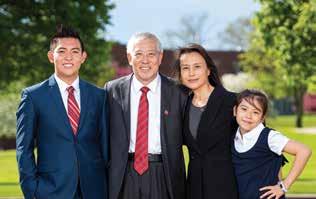
“He has the ability to imagine different courses of action and the consequences of each. He makes decisions and is able to communicate them. He understands there are risks involved in decisionmaking and is willing to take them to move the institution forward, and when it does move forward, everyone else gets the credit.”
The two men met through professional circles, and Wong said he was impressed from the start.
Decision-making is always a part of leadership, and there are decisions to be made at Edinboro, where Huang has two priorities – financial sustainability and enrollment growth. Related goals are tied to improvements in recruitment, retention and revenue. Enhancing institutional distinctiveness will be key to all of the above, Huang said.
This year, the University saw an 18% increase in first-year enrollment – 706 versus 598 last year. The 706 firsttime undergraduates represent the University’s largest incoming class in three years.
Not only are the numbers up, the academic preparedness of first-year students continues to increase, a result of a decision made three years ago to raise admission criteria. The average high school grade-point average is 3.55 for this year’s first-year class, compared with 3.51 and 3.53 in 2018 and 2017, respectively. Attracting better-prepared students will assist with retention and decrease the likelihood that students will leave the University with significant debt but no degree, University officials have said.
While significant strides have been made, there remains work to do, said Huang, who arrived at Edinboro as a second-time president, which is especially helpful at a time when higher education is facing a number of challenges – fewer high school graduates, especially in regions like Western Pennsylvania; some erosion in public confidence in higher education; and intensifying competition for students.
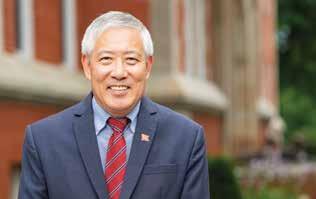
During the coming months, Huang will continue to get to know faculty, staff and students; oversee execution of the University’s strategic plan, “Edinboro 2024”; and focus on financial sustainability and enrollment growth. He will ensure that the direction Edinboro takes is consistent with changes planned as part of the Pennsylvania State System of Higher Education’s system redesign, now underway. Edinboro is one of 14 schools in the State System.
Edinboro’s 19th president said he is hopeful for the future.
“The University has been around for more than 160 years. I am quite confident that it will be around for many years to come.”

“He’s a leader with a panorama of skills; quiet, but steady as a rock.” — Leslie Wong, Ph.D.


 By Nick Warren, ‘07
By Nick Warren, ‘07
It’s easy to feel the history when you walk into a place like Loveland Hall. As one of the centers for the Edinboro University Art Department, it’s a hub for many art students. It’s not the only building that houses Edinboro’s extensive program; Doucette, Hamilton and East Hall are other venues for classes and studios.
Loveland was built in 1931, about a decade after the art department was established. Bates Gallery is located there as well, named for art professor Waldo F. Bates Jr., who was instrumental in starting the department in 1920. Nearby Doucette Hall was named after his colleague, Professor Aime Doucette.
There’s history here, and it’s clear to see just by looking at the layers of paint on the carts and easels that line one of the drawing rooms.
Art leaves an impact. Any art student will be quick to tell you that. For something whose end result is often a clean, beautiful object, there’s a lot of dust left behind in its creation. Hands get covered in graphite, metal flakes, coatings of clay, mineral spirits, inks or whatever the medium of choice happens to be. For decades, this has been the process for countless students. While certain fields like 3D animation, photography and graphic design have transitioned to digital realms, it’s not hard to picture a teenager in 1920 drawing in much the same way one does today. The thread of the arts leads almost directly back for generations ...
Excerpted from an article published in Volume 9, Issue 20 of the Erie Reader on Sept. 25, 2019.
FROM THE BATTLEFIELD TO EDINBORO
Prohibition. The Harlem Renaissance. Women’s suffrage.
The Roaring Twenties yielded significant cultural and societal changes in the United States. At Edinboro University – then Edinboro State Normal School—the decade saw the arrival of talented artist Waldo Francis Bates Jr. and the dawn of a creative legacy.
Bates was born Nov. 1, 1889, in Scituate, Mass., to Waldo Sr. and Georgianna Howard Bates. He attended Massachusetts Normal Art School, now Massachusetts School of Art and Design, in Boston.

After completing his degree in 1912, he studied at the New England Conservatory of Music, where he met his future wife, Catherine; Harvard University; and, later, Penn State University.
In August 1917 – just four months after the United States entered WWI – Bates and other members of the Massachusetts National Guard were called to Camp Mills on Long Island, N.Y., to train for rapid deployment to France. They joined National Guard units from 26 states and the District of Columbia, forming the 42nd Infantry Division and fulfilling Maj. Douglas MacArthur’s vision to expeditiously assemble 27,000 troops.
The division was dubbed the Rainbow Division based on MacArthur’s comments that it would stretch across the U.S. “like a rainbow.”
Prior to deployment, Bates designed a distinctive shoulder patch insignia that each troop wore. It featured a half-arc rainbow of primary colors, a version of which is still worn today by the 42nd Infantry Division. Toward the end of WWI, soldiers modified the patch to a quarter arc in memory of the division’s more than 50% casualties during the war.
In 1920, the Pennsylvania Board of State Normal Schools Principals divided each of the 14 normal schools into specialized service areas, assigning Edinboro the elementary education and art areas. Bates was recruited to Edinboro that year to establish the art department and develop the curriculum.
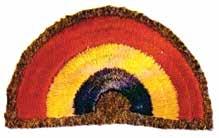
At the beginning of the first year, there was only one student in the department, but all students were required to take a course in normal art. Bates taught blackboard drawing, emphasizing the importance of communicating key concepts using “chalk talk.” He set a high standard for the department and worked diligently to help it grow.


In 1923, Bates founded the ScaRAb Club, an organization aimed at promoting fraternal understanding and harmony among art students. The members frequently dressed in Egyptian costumes and hosted Egyptian-themed activities. Named after the sacred beetle of ancient Egypt, ScaRAb Clubs were forming around the world following the discovery of Tutankhamun’s tomb.

That same year, he recruited Aime Doucette, who also held a degree from Massachusetts School of Art, to join the faculty. Through their efforts, the art education program was expanded to include professional visual arts training.
Bates was recruited by the Metropolitan Museum of Art in New York City in 1924. He declined the offer, electing to stay in Edinboro and finish what he started. By 1925, 45 students were enrolled in the program, and within the next six years, enrollment grew to 115.
A beloved professor, Bates was fondly known by both students and fellow faculty members as “Pop.” He and Catherine regularly invited students to their house on the corner of High and East Normal streets for Sunday dinner – even during the Great Depression, feeding them fresh food from their garden. The 1941 yearbook states that he was the only professor to serve tea in his classroom.
In addition to art, Bates was a talented musician and an active participant in the Edinboro chorus and local church choir groups. His hobbies included beekeeping, philately and genealogy. He was a member of the Society of Mayflower Descendants and the Kinsmen of Presidents, by virtue of his relationship to Abraham Lincoln. His daughters, Frances and Edith, both attended Edinboro and went on to be teachers in California. Well-known in the community, Bates was responsible for taking author Virginia Sorensen to the sugar shack that inspired the 1956 Newbery Medal-winning novel, “Miracles on Maple Hill.”
In 1954, Bates suffered a heart attack and retired from the Art Department after 34 years at the helm. He passed away two years later, but his enormous legacy lives on through Edinboro’s thriving Art Department and the countless artists who have exhibited in his namesake gallery.
Information for this story was provided in part by AnneMarie Sundean, Janet Woods and Hurry Hill Maple Farm and Museum. Photos used courtesy of Catherine Young Boverio, granddaughter of Waldo F. Bates Jr.
“Art has long been something in the clouds, something to adorn with a pink ribbon and place on the what-not in the corner, the bug-bear of teachers and scorn of school directors, but the supreme joy to the child.” — Waldo F. Bates Jr.
1972
Waldo F. Bates Jr. begins his tenure as dean of the Art Department.
Bates founds the ScaRAb Club, a group aimed at promoting harmony among art students. Aime Doucette joins the Art Department faculty.

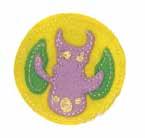
The number of art students grows to 45.
Henrietta M. Kuhn is among the first to graduate from the 4-year program.
Enrollment reaches more than 100 art students.
Loveland Hall, bearing the name of former trustee Francis A. Loveland, is dedicated, and Bates Gallery opens. Delta Phi Delta, a professional honor art fraternity, is founded.
Work is completed on 11 large murals in Normal Hall. Under the direction of Alfred J. Haller, student-artists spent more than two years designing and painting the murals. Enrollment decreases to 58 due to the Great Depression.
Gutzon Borglum, the sculptor of Mount Rushmore, is the honored guest at a dinner held by Delta Phi Delta. There are 90 art majors.

Doucette meets the demands of career-minded war veterans by launching a degree program in commercial art.
Ralph Bruce joins the faculty. East Hall is purchased from U.S. Army Keystone Ordnance Works near Meadville, Pa., and moved to campus.
George E. Hamilton Library is built.
Delta Phi Delta disbands.

Normal Hall burns and murals are destroyed.

The BFA program begins.
Doucette Hall, named after Aime Doucette, is built. The gallery is named Bruce Gallery and dedicated to the memory of Ralph Bruce, who started the gallery and permanent collection.
Baron-Forness Library opens. Hamilton Library becomes Hamilton Hall and houses the School of Arts and Humanities and Nursing Division.
The MFA program is approved by the Department of Education.
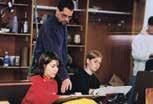
Fire destroys East Hall. Lightning is the suspected cause.
East Hall is rebuilt to meet the needs of the University’s ceramics and sculpture students.
Edinboro University celebrates 100 years of art with a yearlong celebration.
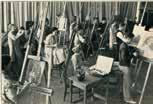

 – Henri Matisse
– Henri Matisse
It’s 2 a.m. on Edinboro’s campus. The library and student center are now closed and the majority of students have retreated to their residence halls. But through the waves of silence, the faint hum of a spinning pottery wheel emerges from the depths of East Hall.
Nearby, a fluorescent glow filters through the windows of Loveland and extends into the darkness. The distinct odor of oil paint wafts down the hall, mixing with the fumes of molten solder wire. Sandpaper scuffs along the grain of a newly carved piece of furniture, revealing the smooth surface below. The walls of Bates Gallery are freshly painted, and a new exhibition has been carefully curated within.
While the campus sleeps, dedicated student artists work to hone their crafts.
Since 1920, Edinboro has trained thousands of art educators and professional artists. What started from a single instructor and one student in Room N3 of Normal Hall has grown into the largest and most prestigious art program in Pennsylvania’s State System of Higher Education.
The visual arts encourage creativity and critical thinking, enhance community engagement, bridge cultural divides, preserve history, and play a vital role in economic development.
Graduates of Edinboro’s distinguished art program have transformed life and culture in the region and beyond. They’ve won six Emmys, a MacArthur “Genius” Grant and countless other prestigious awards.
Susan Swartz has exhibited artwork around the globe –from Budapest to Beijing. Jalil Sadool gave life to characters like Caesar, a super-evolved chimp from “Planet of the Apes,” and Bewilderbeast from “How to Train Your Dragon 2.”
Karen Ross shared her love for art with students in the Lewisburg Area School District for 30 years. Now retired, she transforms the halls of the Janet Weis Children’s Hospital with her colorful murals.
The makers featured in the following pages represent a small sampling of Edinboro alumni, faculty and students who continue to share their talents with the world.
We invite you to read their stories.
“ Creativity takes courage.”

A great teacher can change everything. One such teacher at Baldwin High School did exactly that for Susan Swartz by recognizing and encouraging her artistic talent early on. Upon graduation, he strongly encouraged her parents to send her to study art at his alma mater, what was then Edinboro State College. Following that advice helped to put Swartz on a trajectory that has taken her from Baldwin to Budapest to Beijing, where she has showcased her art to a worldwide audience.
A first-generation college student, Swartz grew up in Pittsburgh’s South Hills, the oldest of three daughters of Margaret (Peg), a homemaker, and Lee Shallcross, a line foreman for Bell Telephone. After high school, she headed north to Edinboro, where she immersed herself in the experience. She studied art, served as a class officer, joined a sorority, sang with the choir, and performed in campus musical theater productions.
“I had a phenomenal experience at Edinboro. I remember the winters, lugging art supplies back and forth. I was involved in everything. My parents were very proud.”
She returned home after college and was teaching art at Baldwin when she met Jim Swartz, a Coraopolis native and Harvard graduate, on a blind date. The couple married soon afterward and moved to Princeton, N.J., where she taught until her children were born. As she raised her son and twin daughters, she spent evenings in her home, teaching art to former students and helping them prepare their portfolios as they applied to colleges. All along, her painting remained a constant.
“I did the festivals and mall shows with Jim right there beside me.”
From those retail outlets and community gatherings, her life has changed dramatically. Since 2008, Swartz has had solo exhibitions around the globe. And there are more international exhibitions to come.
Her stature has also grown domestically. In late August, the art student who once toted her supplies across the Edinboro campus was featured in a concert by Sting in support of Zion National Park in Utah, where a patron gifted one of her paintings to the park for its centennial anniversary.
Swartz said her visibility has increased as her art has evolved, becoming more authentic.
It was a life-threatening illness that changed her approach to her work, which shifted from photorealism to abstract impressionism, highly texturized and bursting with color. Diagnosed 15 years ago with Lyme disease and then mercury poisoning, Swartz was living with extreme pain, potential blindness and the possibility of death.

“I got sick and I had to fight to live. It is one of those battles that grounds you in a different way. I’ve always loved nature, but when there’s a chance you may never see another sunset, each one becomes a blessing.”
The illness, she said, was a gift, adding depth to her work and creating a sense of urgency. Inspiration, which once came from her brain, now comes from her soul.
“My illness caused me to feel and interpret things differently. The spiritual foundation of my work had always been there, but being sick caused my faith to deepen. I wanted my life to be worth something. Surviving transformed my art.”
Robin Marrouche, a friend and director of Utah-based Susan Swartz Studios, has been on the sidelines for a number of years, watching as Susan’s prominence as an artist has grown.
“The paparazzi now follow Susan through Europe, and I love watching that, but she has never been in it for the accolades. She’s worked in solitude, expressing her joy and her love. She’s being true to herself. It’s amazing to watch her energy. When you are doing what you’re put on this earth to do, the universe responds in kind.”
Swartz spends much of the winter in Park City, Utah, summers on Martha’s Vineyard, and also spends time at the home she and her husband share in San Francisco, where his work is based. When in Park City, she paints from a studio in her home, which sits on a peak that affords vistas that are nothing short of spectacular. Each region of the country, Swartz said, offers a different type of light, which keeps things fresh.
Avid skiers and hikers with adult children in Oregon and Boston and nine grandchildren, Swartz and her husband had vacationed in Utah and had a condo there, but wanted to build a home in a place where their family was motivated to visit. The sense of community in Park City was appealing.
“We were looking for a place for our family to visit and happened to read a story about a little boy with cancer who lived in Park City. The entire community had rallied to support him. We liked that.” They also like the easy access to great skiing and the abundance of beautiful hiking trails.
Given her lifelong love of nature, it is somewhat ironic that Swartz’s health crisis was caused by environmental diseases. Her mercury poisoning came from eating fish that had high mercury levels, and it’s likely she contracted Lyme disease while hiking trails in the Utah mountains.
Having Lyme disease led Swartz and her husband to serve as executive producers of “Under Our Skin: The Untold Story of Lyme Disease.” The 2008 film was winner of the best documentary award at the 2009 Sonoma International Film Festival and was a finalist for the Tribeca Film Festival’s Audience Choice Award.
The film is one of many produced by Swartz and her husband, who share a passion for documentary film production. Together, they founded Impact Partners, which has gone on to produce more than 100 significant documentaries, many of which have either been nominated or won an Academy Award. Notable examples include “Won’t You Be My Neighbor,” “Born into Brothels,” “The Cove” and “Icarus.”
Although the environment has become quite toxic, when it comes to her art, Swartz has chosen to focus on its beauty. That being said, all artists are advocates in some way. “If you’re passionate about your work, you have to be an advocate. It’s not something unique to me.”
While she has chosen not to make political statements, Swartz’s art has helped to build bridges, Marrouche said. For example, Utah Gov. Gary Herbert chose the opening of her exhibition in China as an opportunity to announce the first annual Utah-China Friendship Day.

“It’s been interesting to watch the way some countries are using Susan’s art to build bridges,” Marrouche continued. “They understand the power of art to transform and unite, and recognize that by honoring and paying tribute to the environment through her work, Susan has found a way to help us find common ground.”
Her effort to help find common ground is also reflected in her work with Harvard Divinity School, where she has spent 16 years as a member of the Dean’s Council. Her introduction to the school came through a retired Harvard faculty member whom she met at an art show on Martha’s Vineyard. He invited her to serve as an artist in residence at the Divinity School, which led to the Dean’s Council appointment.


China Central Academy of Fine Arts, Beijing, China (2018)
Manetti Shrem Museum at UC Davis, Davis, California (2018)
Ludwig Museum of State Russian Museum, St. Petersburg, Russia (2017)
Ludwig Museum of Contemporary Art, Budapest, Hungary (2016)
Ludwig Museum, Koblenz, Germany (2015)
Kollegienkirche, Saltzburg, Austria (2014)
National Museum of Women in the Arts, Washington, D.C. (2011)
Springville Museum of Art, Springville, Utah (2010)
Utah Museum of Fine Art, Salt Lake City (2008)
And there are more international exhibitions to come.
“I’m very right-brain and an out-ofthe-box thinker, which they apparently found appealing,” Swartz said. “The school serves 33 different religious traditions, which work together to look at what they have in common rather than their differences. It’s an exciting place to be.”
Marrouche said she wasn’t around to see Harvard’s presidential portraits coming down to make way for Swartz’s paintings during her stint as an artist in residence, but she had long been a fan, even before they began working together.
“I had been following her art,” said Marrouche, former executive director of the Park City-based Kimball Art Center. “When she did the exhibition at the National Museum of Women in the Arts, I asked her what it felt like to be recognized in that way. I was struck by what a humble and decent human being she was. I asked her to participate in an arts salon so that we could water ski behind her success.”
At about the same time, Swartz’s cousin, who had been helping to manage her exhibitions, died after a brief battle with non-smokers lung cancer. Swartz invited Marrouche, who had left the Kimball, to step in to manage her international shows.

“For someone seeking strong women role models, I’ve found one. It’s been an amazing friendship,” Marrouche said.
Just as she’s provided guidance and served as an inspiration to Marrouche, Swartz has some advice for Edinboro’s student artists, those who have shared the experience of the winter walks along Mallory Lake, portfolios blowing in the wind.
“Be true to yourself. If you’re rightbrained and in the arts – any kind of art – it’s a special gift. Earlier in my career, I got into the trap of painting for judges. Ironically, my commercial success came when I was true to myself.”
Patience, she said, is also a virtue. “Sometimes, we want things right away. If we get them, we don’t appreciate them.”
Swartz said that as she ages, her opportunities continue to increase. “It’s a gift that touches my heart because those opportunities are born of life experience. When you’re just starting out, you learn the rules. Later, you learn through life. Everyone has struggles. It’s what you do with them. They can bring you down or you can grow from them.
“Being very sick allowed me to see how many people had it so much worse. It made me realize that every day is a gift.”
Although life has taken her far from Western Pennsylvania and down paths she never imagined, her ties to the region remain strong.

“There’s something about growing up in Western Pennsylvania, where it was about hard work. That work ethic and humility are what I grew up with. Those roots stay with you.”
To learn about Swartz’s art, visit susanswartz.com.

“For someone seeking strong women role models, I’ve found one.”— Robin Marrouche
AT EDINBORO UNIVERSITY, JALIL SADOOL LEARNED TO MAKE HIS DREAMS COME TRUE
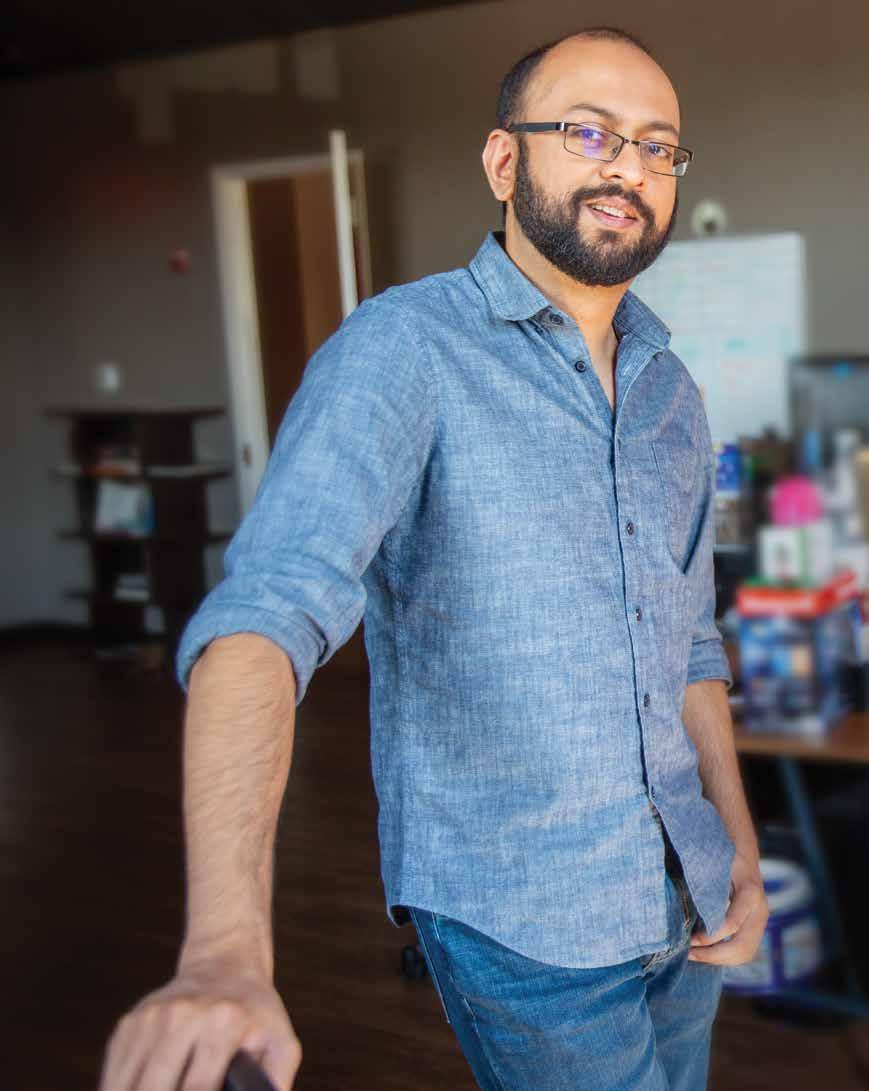
These are words no young person wants to hear from their parents after declaring to them their dreams. Yet it was a reaction that Jalil Sadool probably expected when he told his father he planned on moving to Edinboro, Pa., to study animation.
A few years earlier, Sadool had just finished watching “Jurassic Park” with his father when he told him that he would one day work with Steven Spielberg.
“Just do your homework,” his dad scolded. “And stop dreaming.”
“My dad was all about me becoming a doctor or engineer,” Sadool said. He did, in fact, study engineering in Singapore for two years. It was after he read a magazine article about an animator named Mike Genz who taught in the Edinboro University animation department that Sadool decided it was time to change course and follow his true dream.
From his home in Mauritius — a tiny island in the Indian Ocean off the coast of South Africa — Sadool contacted Edinboro. It wasn’t long before he arrived at the school and knew almost immediately that it was where he belonged.
“I was meant to come to the United States,” he said. “My dad was a movie buff. I grew up with American culture. When I got here, I felt like I was home.”
That was how Sadool’s dream started — a dream that would eventually lead to him working with Steven Spielberg.
As a kid, when Sadool would watch cartoons he imagined they were created by angels. He never dreamed that there were real people behind the scenes bringing his favorite ’toon types to life.
After working as an animator on “Avatar,” “The Chronicles of Narnia,” “Night at the Museum” and “Charlotte’s Web,” the 40-year-old now knows who is really behind the magic. “Animation is accomplished by a bunch of hardworking, talented people.”
Before beginning his career in film animation, he learned some down-toearth lessons at Edinboro in the animation classes of a former Disney animator whose credits include “The Lion King” and “The Little Mermaid.” The professor was none other than Mike Genz.
During his junior year, Sadool told Professor Genz his class project would be a live-action film with animated visual effects. Halfway through the semester, Genz noticed that Sadool hadn’t started the animation and warned that he probably wouldn’t pass the class.
“Mike told me I was spreading myself thin, that I had to pick one or the other,” Sadool recalled. “That really woke me up.” So, he scrapped the liveaction film and decided to do a small, hand-drawn 2D animated short.
“I realized I was having fun doing animation. I could sit in my room and tell stories with a pencil and paper. After that, I focused thoroughly on animation.”
Once he graduated in 2004, all he had to do is find a job and prove to his father that he could earn money from his artistic dreams.

“You will die a poor artist.”
“I realized I was having fun doing animation. I could sit in my room and tell stories with a pencil and paper.”
After sending VHS tapes of his work to 72 studios, Sadool got a reply from a company called Rhythm & Hues. They invited him to L.A. for a month-long internship along with 11 other candidates, all competing for just a few positions.

Each day, he gathered in a room with his competitors, developing characters for “The Chronicles of Narnia.” When the program ended, all 12 participants received certificates and went back home — and waited.
“For a couple of days I just sat by my phone,” Sadool said. Then one day he got the call — and the job. He stayed at Rhythm & Hues for two years before moving to New Zealand to work at Weta Digital, the studio cofounded by “The Lord of the Rings” director, Peter Jackson.
At Weta, he finally worked with Spielberg on “The Adventures of Tintin,” the story of a dog who helps a sea captain find a sunken ship filled with treasure. Unfortunately, Sadool’s father had passed away before he realized his dream of working with his idol.
Then came the apes.
The next adventure of Sadool’s journey would be at DreamWorks, but before leaving New Zealand, Sadool completed one last film at Weta — “Rise of the Planet of the Apes.” More than just a reboot of the original “Planet of the Apes” movies, “Rise” tells the story of how the beasts developed the human traits that would eventually put them in charge of the planet.
Though he says he’s not actually the father of the movie’s main simian, a super-evolved chimp named Caesar, he admits that as the film’s lead animator, he feels like he helped raise him from an infant to ape adolescent.
Sadool says the body and facial movements of the creatures in “Rise” needed to be nearly perfect so that audiences would believe they were watching “real” apes and not humans in costumes like in the 1970s version of “Apes.”
He credits Andy Serkis, who portrayed Gollum in “The Lord of the Rings,” for bringing Caesar to life. With electronic sensors and green motion dots attached all over his body, Serkis acted out Caesar’s actions and emotions while filming with actors like James Franco. Afterward, Sadool and his team created the animated ape based on Serkis’s movements.
“Andy was phenomenal,” Sadool said. “As good as we are, there’s no Caesar without Andy.”
Despite his early concerns that “Rise” would flop, fan reaction and big box-office numbers guaranteed two more “Apes” movies. By that time, Sadool had moved on to DreamWorks, the studio cofounded by Spielberg.
After that, he lost track of Caesar for a while.
Despite his success, Sadool was not immune from the pressures of the movie industry. After a few years at DreamWorks, he requested a smaller role on his next project, “How to Train Your Dragon 2.”
Although he was at first relieved not to be a lead on the team, after he saw some of the early storyboards from the film, he changed his mind and asked for a bigger role. He was put in charge of animating a character named Bewilderbeast, a monster that resembles a gigantic triceratops covered with spikes and wings, and with a really nasty disposition. That put a smile on Sadool’s face.
“I realized that I had this monster to scare the world,” he said. “It reminded me of freaking out my cousins with scary recordings I made (when we were kids). That project saved me and made me love the industry again.”
After “Dragon 2,” Sadool shifted focus.
At Steamroller Studios, located in the tiny central Florida resort town of Mt. Dora, Sadool shares an office with one of the fellow cofounders. If pressed, he’ll tell you he’s also the company CEO.
At Steamroller, you’ll find a diverse crew of mostly younger people, intensely focused on multiple computer monitors as they flesh out the heroes and villains for some of the gaming industry’s most popular titles. Among the roster are “Fortnite”, “Shadow of the Tomb Raider,” “Deus Ex” and “Prey”—and a few more on the drawing board that can’t yet be named.
While Steamroller isn’t creating these games, it is bringing their characters to life. “In that respect, games aren’t much different than movies,” Sadool said.
“Animation is animation. There are different requirements and different tools for each. But when an audience is watching a game, they want to believe in the characters, just like when they watch a movie.”
Though he’s not currently working in film, a constant reminder from his movie days lurks just a few feet from his office desk — a bust of Caesar. The main character of “Apes” still tugs at his heart.
“After I left Weta, I didn’t have time to see the other two “Apes” movies. Before the third movie came out, I rented the second one and went to see the third movie the next day. I wanted to see how it turned out.”

“At the end, I was crying. I brought Caesar to life and now I’m seeing him go. Then my wife looked at me and said, ‘You gotta stop,’” Sadool said with a laugh.

Almost 20 years after he arrived in the United States, Sadool will tell you, “Edinboro is home for me.” A big reason is the education he received there.
Of course, Mike Genz played a huge role in shaping his career, but Sadool credits current faculty members D.P. Warner and Terry McKelvey, former faculty member Jim Dunlap, and Linda Kightlinger, who oversees the University’s Global Education Office, for so many other indispensable lessons learned.
“I valued everything my teachers were saying. They were people who left a mark on me I won’t forget,” he said.
Sadool also appreciates the opportunities Edinboro gave him to mature as a person.
“I did a lot of growing up there. I’m still very close to some of my friends and instructors. I have good memories of home.”
“Edinboro is where I discovered snow,” he said. “I remember walking in it and dragging my art supplies to class. I’ll never forget that. That’s why I’m in Florida today.”
Wherever he calls home, Sadool is living proof that dreams can come true — and can pay off nicely.
“I valued everything my teachers were saying. They were people who left a mark on me I won’t forget.”By Stacey Federoff
TWO GRAPHIC DESIGN ALUMNI CREDIT EDINBORO EDUCATION WITH THEIR ROLES IN AWARD-WINNING MAKEOVER FOR IRON CITY BEER

 ALUMNI PROFILE
Aaron Easler Ian George
Top Hat’s Aaron Easler and Ian George say Edinboro’s foundation helped them build careers at the Pittsburgharea branding, web design and development agency.
ALUMNI PROFILE
Aaron Easler Ian George
Top Hat’s Aaron Easler and Ian George say Edinboro’s foundation helped them build careers at the Pittsburgharea branding, web design and development agency.
Earlier this year, I.C. Light beer sold out across the Pittsburgh region.

Cases of the lager ran out a week and a half before a new month’s supply from Pittsburgh Brewing Co. was ready.
Customers were angry, but Aaron Easler and Ian George were elated.
The two 2015 Edinboro graphic design alumni work at Top Hat, the Millvale, Pa.-based creative marketing agency that redesigned Iron City Beer and its sister brands just over a year ago.
With the brewery ramping up production to meet demand, the Top Hat team knew the updated branding had worked, because the formula for the beer hadn’t change.
“This is something where we knew the success or failure of what we did was going to be pretty apparent,” said Easler, Top Hat’s creative director, explaining the crisp lines of the new red and yellow circular logo on a white background. “We tried to make it something that every piece of it was new, but people might look at it and think it’s just like what it’s been forever.”
The rebranding won the agency a national Silver Anvil Award and two honorable mentions from the Public Relations Society of America, two design awards from the Pittsburgh chapter of American Institute of Graphic Arts, and 12 Renaissance Awards from the Pittsburgh PRSA, who honored Easler as “Entrepreneur of the Year.”
The brewery is one in a range of Top Hat’s clients from nonprofits to start-ups.
“We’re all really fortunate to be working on the type of projects and with the type of clients that you hope to ‘maybe someday’ work with at some point in your career,” Easler said.
George said the open, honest atmosphere makes Top Hat feel like a true team.
“Other places I’ve worked at … you just kind of felt in the dark a lot of times, whereas here, I constantly feel up to speed on everything,” he said.
Easler grew up in Allison Park, a Pittsburgh suburb, and created graphics for go-karts as a teenager.
“I was going to start working at a print shop right out of high school,” he said. “The designer there was like, ‘You aren’t going to be able to get a job at any of the big agencies in Pittsburgh if you don’t have a college degree,’ so I went home and said, ‘All right, Mom, I’m going to college.’”
He visited Edinboro and was hooked by the quality of student work on display.
“It looked promising and impressive, and like something I wanted to be a part of,” Easler said.
At one point, he lived across the hall of an off-campus apartment building from George, who grew up in Mercer, Pa.
George was influenced in part by his dad’s experience as a watercolor artist but was drawn to graphics more than fine art.
His dad, Stephen, attended Edinboro in the 1970s and his brother, Philip, graduated with a degree in elementary and special education in 2010.
“Right off the bat, I knew that it was the right place to go,” George said.
As a student, the way graphic design is “meshed” within Edinboro’s art department helped George earn an appreciation for other media, like his minor concentrations in printmaking and wood furniture.
“I think you learn a lot by exploring things outside of design,” he said. “I liked getting to do more hands-on kinds of art classes and projects, and I think they influenced each other.”
Design doesn’t always lead to one prescribed career path, or one way to solve a problem.
“We are pretty flexible in terms of what we’re willing to attempt to do, and figure out how to do that for clients when the task calls for it,” Easler said.
Ben Butler, who founded Top Hat in 2013 before he graduated from college, said each person on the six-person staff brings something different to the team.
The agency’s projects come together when Easler uses his business savvy and design experience to complement George’s illustrations and motion graphics alongside the rest of the team.
“We’re like a stew,” Butler said. “Every one of these guys is a core ingredient that has radically made the dish even better.”
“I liked getting to do more hands-on kinds of art classes and projects, and I think they influenced each other.”
Weighing just 2 pounds, 5 ounces at birth, Karen Ross considers herself a “miracle baby.”
Her mother had no idea of this early arrival. Unprepared and wracked with nerves, the expectant mother arrived at Geisinger Medical Center to deliver a future artist who decades later would transform the halls of the hospital.
“They didn’t give up on me,” said Karen Ross, an Edinboro University art graduate, retired schoolteacher and practicing artist. “This is now my opportunity to give back.”
Fast-forward to the 1990s, when Ross discovered a way to incorporate her artistic skills into the hospital that saved her life as a premature baby – the Janet Weis Children’s Hospital of the Geisinger Medical Center in Danville, Pa.
For the past 25 years, Ross has constructed and installed seven murals in the children’s level that depict playful images of frolicking children, floral gardens and teddy bears. What was once a hallway of uninspired, empty walls with burnt-orange accents is now a colorful, bright display of pastels and acrylic paint, framed artwork and cheerful murals.

Ross, who retired from Lewisburg Area School District in Lewisburg, Pa., after teaching art for 30 years, started small. Using children’s artwork that she collected, the artist used an overhead projector to trace the images onto plywood. Then she cut out the images. From there, the murals were painted and glossed to become permanent displays.
Immediately, Ross felt the impact.
As she sat on the hallway floor one day, mixing paints and organizing her paintbrushes, a distraught young man stepped off the elevator and approached her. The man, whose newborn baby was at that moment undergoing open-heart surgery, eased the tension in his face and shoulders and mustered a smile.
“I just want you to know,” the man started. “I just got off the elevator, and I was just full of anger, rage and frustration. I was beside myself. When I looked at your murals, it put a smile on my face and cheered me up.”
Stories like these aren’t uncommon to Ross, who has transformed the topography of the hospital with her creativity. But it’s not a simple project that she throws together in an afternoon. Each of the seven main murals took approximately 250 hours to complete.
“It’s worth all the time and effort because this is something new and different from what anyone had ever seen,” she said.
After choosing the image and creating the plywood structure, Ross shapes the image with Sculptamold – a substance similar to plaster of Paris that results in a stone-like finish. When the mold dries, it’s time to apply Temper paint and a Fanbrush acrylic paint. When the painting is done, a thick layer of protective gloss is applied – not only to protect it but so that passers-by can touch the artwork.
Yes, Karen Ross wants you to touch her artwork.
“Children love to walk by and touch the murals,” she said. “And grownups, I have to look at them and say, yes, you can touch it too.”
This type of artistic outreach is addicting, Ross said. With every child who gives her a hug or comes back to visit to thank her, Ross confirms her mission as a healer through art.
“This just absolutely touches my heart,” she said. “I have put all of my other artwork on hold so I can focus on the murals. This comes first. I have even put it ahead of dating.”
Not only are the murals recognized by patients and their families, but the hospital staff and doctors are also taking notice.

“These beautiful murals have become a fun part of the hospital that puts many of our young patients at ease and brings joy to their families,” said Gloria Gerrity, vice president of Geisinger’s Women and Children’s Institute. “The artwork also plays a vital role in patient care, as it encourages many of our patients to get out of bed and moving to visit them, which positively impacts their treatment and healing.”
Ross knew as a child that she was destined to be an educator – to impact the lives of children – but it wasn’t until her arrival at Edinboro that she discovered art.
Her family relocated to Brookville, Pa. (home of the historic Brookville Waterworks Dam), when she was a child, and she fell in love with the smalltown atmosphere. She chose Edinboro University because it was the perfect size and because Edinboro Lake and Lake Erie reminded her of home.
After graduation, Ross dedicated the next three decades of her life to educating young artists – touching the lives of those who are discovering illustration and animation for the first time.
Although Ross doesn’t seek accolades for her work, she knows that the murals – and her creative legacy – are permanent installations at the Geisinger Medical Center.
Literally.
She constructed them with heavyduty, disaster-proof material – just in case. The medical center staff would joke that if an earthquake struck, the murals would be safe.
And in July, a 3.4 magnitude earthquake hit Juniata County – just 55 miles from Geisinger.
“Geisinger shook, and things were falling down all over,” Ross said. “But there weren’t any cracks in the murals. They aren’t going anywhere.”
“Children love to walk by and touch the murals. And grownups, I have to look at them and say, yes, you can touch it too.”By John Altdorfer

“Maybe we shouldn’t sit too close to the waterfall,” Tricia Zigmund says. “I think they put mothballs in it to prevent algae growth, and the smell might be a little overwhelming.”
She’s right. In the Cascade Café of the National Gallery of Art in Washington, D.C., the faint whiff of your greatgrandmother’s winter clothing drawer wafts from the glass-enclosed falling waters designed by architect I.M. Pei.
Moments later, the ammonia aroma fades. And the 2007 Edinboro graduate remembers over a steamy cup of coffee when she first fell in love — with photography.
“In high school,” she said, referring to her time at North Schuylkill Jr./Sr. High School in Ashland, Pa., “I wrote HTML for hours on the computer every day. My plan was to become a web designer.”
But a new art teacher changed everything about North Schuylkill’s photography class — and Zigmund’s plans. Till then, the curriculum had consisted of students cutting photos out of magazines. No one ever clicked a shutter.
Before long, that teacher, Kerri Gaugler, bought cameras and transformed a closet into a darkroom so students could print their own photos.
That’s when the computer coding world lost one of its most devoted nerds and the photography community gained a committed convert.
“I couldn’t stop taking photos and working in the darkroom,” Zigmund said. “It was total immersion.”
Still, she didn’t think she could make a living with a camera — until Gaugler suggested that photography might be Zigmund’s true calling. After that, she “couldn’t think of doing anything else.”
These days, the 34-year-old is a staff photographer at the Gallery, where she takes pictures of art treasures from around the world. She’s also worked at the Museum of Modern Art in New York City and the J. Paul Getty Museum in Los Angeles.

Of course, Zigmund’s journey from her small-town high school to the nation’s capital includes a significant four years at Edinboro.
Unlike some bigger schools, where coursework can consume a student’s every moment, Zigmund said Edinboro provided the freedom to choose the path she wanted to take as a photographer.
While some of her fellow students ventured into photojournalism or commercial work, she chose a conceptual route.

“I couldn’t stop taking photos and working in the darkroom.”
SHE ONCE DREAMED OF DESIGNING WEBSITES. NOW, TRICIA ZIGMUND PHOTOGRAPHS THE WORLD’S ART TREASURES.
Even in high school, Zigmund admitted, she was never into “straight” photography. One of her earliest prints shows her sister holding a flower that blocks most of her face — a not quite in-focus image she altered in Photoshop to look almost like a color negative.
“Kathe was a real force and amazing adviser,” she said. “Sarah was my Photo 1 professor and enabled me from the start. And Fred helped me understand that there is a point when you learn enough about lighting and how the camera works to know how to make a picture look the way you see it in your head.”
Oh, yeah, this Tricia Zigmund also posts cat photos on her Instagram account — a coincidence that makes her smile. Her kitty images are the closest she comes to taking “normal” snapshots.
At Edinboro, where she earned a Bachelor of Fine Arts in Applied Media Arts: Photography, three professors — the late Kathe Kowalski, Sarah Wichlacz and Fred Scruton — particularly encouraged and fostered that creativity, so much so that by the time she graduated, Zigmund had displayed work in numerous judged exhibits.
Before you type in “Tricia Zigmund” on your computer browser to see those photos, here’s a warning: Don’t confuse her with the Tricia Zigmund on Twitter who takes selfies with her cat. That’s another Tricia.
Instead, look for the Tricia Zigmund who appears in many of her photos as a shadowy or blurry figure who may be chasing invisible crows across a sun-scorched cornfield or shakily balancing on bare mattress springs in an abandoned house.
Though only 34 years old, Zigmund said it’s easy to imagine working at the Gallery for the foreseeable future — even if she was a little tentative when she started nearly eight years ago.
“Many of my colleagues have been here for a long time,” she said. “Some of them for their entire careers. But the longer I’m here, the more I understand why. It’s an amazing experience to photograph some of the best art in the world every day. So why would I change that?”

“It was total immersion.”
“It’s an amazing experience to photograph some of the best art in the world every day. So why would I change that?”
“If it hadn’t been for the art program, I couldn’t have survived in a college setting.”
STUDENT PROFILE
 By Christopher LaFuria
By Christopher LaFuria
When Analisa Johnson takes her seat at the pottery wheel, a lengthy checklist of ideas spins through her head as she begins throwing clay.

“If I mold the base of this mug more narrowly, will it still support the mouth and the walls? Did I stir the glaze enough before I kiln-fired the mugs?
“Have I painted this design before? Is this handle strong enough to match my design and contain some fresh-brewed coffee without breaking?”
Right before the start of her senior year at Edinboro University, Johnson was diagnosed with attention deficit hyperactivity disorder, a condition that has affected her study habits and test-taking. A cinema major with a concentration in film and video and a minor in ceramics, she hasn’t let the diagnosis slow her down.
Despite the waves of information and questions that penetrate her brain at any given moment, Johnson finds clarity in the ceramics studio.
“If it hadn’t been for the art program, I couldn’t have survived in a college setting,” said Johnson, a senior from Milton, Pa. “This has been a pretty good way to get my brain to function the way I need it to.”
Begriming her outfit with brown clay and digging her fingers into a future mug or ceramic bowl, Johnson clears her mind of the stress of college life and the jagged road that led to her final year at Edinboro.
Johnson arrived at Edinboro having no experience in the art studio. As a high school band and chorus student, art courses always seemed to conflict with her schedule.
But at Edinboro, she was determined not to miss her opportunity. In addition to making student films and designing ceramics, Johnson has been an active peer educator in the Ghering Health Center and is joining Edinboro’s Clay Club this semester.

As a self-identifying queer student, Johnson has also volunteered her time as an executive member of Identity, Edinboro’s LGBTQIA inclusive club.
At Milton Area High School, she caught the video bug after creating commercial videos and contests for women’s mental health organizations and developing her video journalism skills. On weekends, she filmed and photographed weddings and edited the content. That’s why Johnson decided to major in film – to become a video editor.
The wife of George Lucas, creator of the “Star Wars” franchise, she earned the 1977 Academy Award for Best Film Editor.
“If she hadn’t done all the edits that she did, no one would remember ‘Star Wars,’” Johnson said, “because the original draft was insane and made no sense whatsoever.”
During her career as a student-filmmaker, Johnson has earned her own accolades. Her first feature film – “Colors of the Rainbow,” a minidocumentary of interviews with LGBTQIA students of color on campus – earned an entry in the David Weinkauf Student Film Festival.
“At the time, I was the only minority person in my film class. It felt like – at times – that I was alone,” said Johnson, whose father is African American and mother Dominican. “People don’t usually talk about these issues. So this gave me the prompt I needed for the documentary.”
Edinboro students and officials have taken notice of Johnson’s work with diversity, gender and sexual-orientation activism. Terrence Mitchell, chief officer of Diversity and Inclusion, views these efforts as essential to the University’s mission to provide an inclusive culture.
“We are so proud of all of our student’s efforts to grow and learn through experiences with peers, professors and employees who represent the diversity of our campus community,” he said. “Students – like Analisa – who have these experiences are more prepared for life after college and are the leaders of tomorrow.”
As a filmmaker and ceramicist, Johnson knows she has stories to tell about her experiences. Whether it’s living with a chronic hyperactivity condition or navigating life as a black queer college student, she is ready to share these stories.
“I only know my experience,” she said. “I can only tell people what life is like through my eyes.”
But the Art Department facilities are where Johnson feels most at home.
In her second-floor home studio above a garage, Cappy Counard can watch an apple tree change with the seasons as she works at her jeweler’s bench or with her soldering tools.
“It’s my place of solace in a busy life,” she said.
Working on pieces with intricate detail, the Edinboro art professor of jewelry and metalsmithing said she is drawn toward meticulous processes.
“If you have something that fits in the palm of your hand, you have to get close to it,” Counard said. “The older I get, I appreciate the quieter things and those that are more detailed.”
Now on display at the Mercer Museum in Doylestown, Pa., an exhibit Counard curated also reflects that notion.
“Forging a Link: Metalsmiths Respond to the Mercer Collection” opened Sept. 28 and continues through Jan. 5, 2020, at the Bucks County museum.
Counard also contributed her own pieces, “Objects of Connection,” which were inspired by kitchen objects. “Unison” features a black disc and a silver disc that fit together with a comblike structure, while “Join” includes two metal beads on a necklace made of black and white horsehair.
“It took me an entire day just to tie them together,” she said. “Repetitive acts are like acts of care for me. … I’m trying to create a space where things come together, and that became a space for connection.”
From its beginnings in 2016, a collaborative spirit informed the entire exhibit, for which Counard enlisted 23 blacksmiths, metalsmiths and jewelers.

They visited the museum together and were able to explore in great detail its collection, first gathered by Henry Mercer in the early 1900s to preserve tools and objects from before the Industrial Revolution.
“He saw that by losing the ability to make things by hand, we were losing something as a culture, and this is a way to honor that,” Counard said. “Artists still create things by hand in our culture today… . Through art, we’re trying to do the same things he was. We’re wellmatched together, even if we didn’t come from the same worlds.”
The exhibit also serves to immerse contemporary pieces within the historic collection, allowing visitors to see the connection between the two, said Cory Amsler, vice president of collections and interpretation at the Mercer Museum.
“It’s encouraging that sense of surprise and rousing people out of their everyday perspectives and considering something new,” he said.
Counard joined Edinboro’s faculty in 1999, just after she earned a Master of Fine Arts degree from Southern Illinois University at Carbondale. She has traveled and created metalwork overseas and holds a bachelor’s degree in art from the University of Wisconsin-Madison.
Fellow art department faculty member Sue Amendolara, whom Counard counts as a mentor, also contributed a piece to the Mercer Museum exhibit, as did alumni Nash Quinn and Jera Lodge.
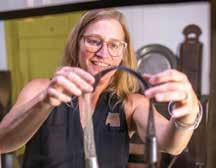

“We believe students should have a really solid foundation in the technical aspects of metalwork,” Amendolara said. “Then as they move along, we talk to them about their personal aesthetic that goes into the work.”
The legacy and emphasis on art built by Edinboro that has endured for 100 years continues to be evident in today’s students, who Counard said dive in, then become passionate leaders as they progress with their work.
“What I find consistently, our students don’t take things for granted; they are grateful for every opportunity,” she said, adding that she often sees students with different backgrounds come together and understand their different strengths.
For her personal work, Counard is grateful that Edinboro allows faculty to take a sabbatical every seven years to “reset” and build bodies of work, which has been “incredibly valuable to remaining relevant” as an artist.
Even celebrating the centennial anniversary of art and art education in northwest Pennsylvania with Art 100 speaks to the way the University values art.
“It’s remained at the core of Edinboro’s identity,” Counard said. “It makes me feel so valued by the University and our community.”

Amendolara’s piece for “Forging
A Link” was inspired by the Mercer Museum’s collection of wallpapering and fabric printing, as she is the daughter of an interior designer. Her piece, “Help Me Say Goodbye,” has deconstructed upholstery scissors, rendering them ineffective at cutting through the pain of loss.

“I was a little intimidated because I’ve never made a tool before,” Amendolara said. She eventually decided on the scissors, which are embellished with holly to represent the passage of life, set on fabric from her wedding dress, further evoking the connection to family.
“I’m excited to see all of the pieces,” she said. “It’s going to be really interesting to see all of them side by side and how the artists interpreted the project.”
“What I find consistently, our students don’t take things grantedfor ; they are grateful for every opportunity.”
EDINBORO’S TALENT SHOWCASED FOR MILLIONS WHO PASS THROUGH PITTSBURGH’S AIRPORT
By Christopher LaFuria“The art program at Edinboro University is robust, led by faculty who are recognized both nationally and internationally,” Rearick said. “The alumni of Edinboro are just as skilled.”

Hurried travelers with restless children point to their gate and sprint through the airport halls.
A pair of businesswomen grab coffee and stroll through the hectic entryway under harsh fluorescent lighting.
A father and son browse a collection of ads for travel agencies, casinos and regional colleges.
Some of the busiest transportation hubs fall victim to these stereotypes of dull, monotonous airport terminals.
And then there’s Pittsburgh International Airport (PIT), which has created a vibrant gallery of local art with the help of Edinboro University faculty, students and alumni. From expansive displays of Japanese Nihonga painting at the ticket gate to fabricated steel sculptures in baggage claim, travelers can gather themselves and catch their breath by viewing work from Edinboro’s finest.

“Because an airport is the gateway to a region, showcasing local artists and artist communities is an opportunity for passengers to connect with local culture and learn more about local amenities,” said Rachel Rearick, arts and culture manager for the Allegheny County Airport Authority, who graduated from Edinboro in 2006 with a fine arts degree in printmaking.
More than 9 million passengers traveled through Pittsburgh International Airport in 2018, according to PIT. As they departed for vacation or returned home for the summer, they have witnessed firsthand the legacy of Edinboro University’s Art Department.
Through the stories of Rearick, who earned a minor in art history; faculty member D.W. Martin, who teaches sculpture; and graduate Hiromi Katayama, an expert in traditional Japanese art, this Edinboro artistic experience comes to life just like the walls of PIT.
When she analyzes her work with the Airport Authority, Rearick views her job not so much as a gallery owner but as a community advocate – a role she has played since relocating to Pittsburgh after graduating from Edinboro.
She has served in many advocacy roles, such as board member for Artist Image Resource, youth mentor for Big Brothers Big Sisters and active member of the Associated Artists of Pittsburgh. She has also coordinated exhibitions throughout the region – with the most recent titled “Brooching: Identity and Gender,” which explored themes of individual craftsmanship and personal identity.
“Pittsburgh has a long-established arts community and is bursting with artistic talent,” said Rearick, who found a natural progression from community activist to professional arts manager.
Since she joined the Airport Authority in 2018, Rearick has been tasked with researching and developing arts programming; coordinating installations and programs; managing 12 rotating, temporary art spaces; and promoting the PIT Performing Arts Series.
The work can be as stressful as navigating a bustling terminal, but Rearick has helped to find a solution.
“Having art in an airport setting improves the experience for people as they move through the space,” said Rearick, who combines the local art with internationally known work from Andy Warhol and Alexander Calder. “We are pleased to feature local artists and their work alongside world-famous pieces – available for more than 9 million passengers, airport employees and airport visitors each year.”
Rearick has also helped connect Edinboro faculty and alumni with the airport, often arranging for temporary displays throughout the terminal and exterior. She worked with Martin on his steel sculpture at the baggage claim, coordinated the Allegheny Metals Collective display, that included Edinboro faculty Cappy Counard and Sue Amendolara as well as instructor Adrienne Grafton, and assisted Katayama with her ticketing-level art case.
“The art program at Edinboro University is robust, led by faculty who are recognized both nationally and internationally,” Rearick said. “The alumni of Edinboro are just as skilled.”
D.W. Martin usually doesn’t respond to every email that includes a call for artist proposals. But an email from a friend that outlined the Allegheny County Airport Authority project piqued his interest. The airport was looking for ready-made works that simply needed to be relocated and installed into a predetermined area.
That’s where “Power Surge” came in – Martin’s fabricated, welded steel sculpture with six separate parts, designed to be bolted together into a sculpture that measures 25 feet long, 100 inches tall and 5 feet wide.
Including the powder coating and achieving the desired surface designs and textures, Martin spent nearly two years working on “Power Surge” along with his full-time duties as sculpture professor at Edinboro.
“The image I created is essentially recognizable as a serpentine kind of form that is anthropomorphized with a telephone pole,” said Martin, who has taught at Edinboro for nearly two decades. “Electrical elements, shapes and forms such as pylons, transformers, currents and voltage have been a central interest to my imagery for some time now. Anything that moves or carries electricity feeds my creative curiosity.”
As the artist in residence for Bentworth High School, a public school in Washington County, Pennsylvania, Katayama uses her artistic creativity and experience as an educator to connect high school students with traditional Japanese art.
Katayama collaborates with students and faculty at Bentworth through the Rural Arts Collaborative, an agency that supports art education and exhibitions in rural Pennsylvania.
At the school of nearly 400 students, Katayama has invigorated the art curriculum with Nihonga, a centuries-old Japanese water-based painting art form. While the term Nihonga has existed since the 19th century to describe techniques using material like paper, silk, wood and plaster, Katayama favors ancient methods.
“It’s a historical way of painting in Japan,” said Katayama, who graduated from Edinboro with a Master of Fine Arts in Painting in 2012. “It uses traditional materials, such as natural pigments, oyster shell powders and crushed minerals, mixed all together by hand.”
A native of Ibaraki, 65 miles northeast of Tokyo, Katayama fell in love with creative art and painting long before earning a Bachelor of Fine Arts from Joshibi University of Art and Design. Working with high school students has given her an opportunity not only to share her passion for colors and design but also to share her culture with her new Pennsylvania neighbors.
Katayama and Bentworth High School brought this collaboration to life at PIT with a sprawling mural dedicated to Japanese and rural Pennsylvania culture. The teams designed and installed the artwork – it spans 10 panels and includes nearly 5,000 origami cranes – at the main ticket-level entryway.
Bentworth students designed “Wildlife of Bentworth,” a painting depicting the local fishing culture, while Katayama contributed “Beyond Culture” to express personal culture and individualism.
“This was very exciting because not only does it show my work with traditional painting,” she said, “but it also helps incorporate my cultural art form from Japan.”
Currently, Martin’s “Power Surge” welcomes visitors to the Pittsburgh International Airport, as the colorful serpent-like design rests outside of baggage claim. There it will remain for five years, the duration of the temporary art installation.
“As an artist, we need these opportunities to get our work out in the public eye, wherever it might be,” he said. “This shows a continuity of art programs in our region, and reaching out to all artists and not only locally based artists. It shines a bright reflection of the level of creative talents that the artists in our area possess, and that we are being recognized for it.”
In addition to his sculpture at the airport, Martin has also exhibited his work extensively in the region through the Midwest Sculpture Initiative. He has exhibited in Knoxville, Tenn.; Charlottesville, Va.; Lewistown, N.Y.; and at the Erie Art Museum in Erie, Pa.
But having this sculpture displayed at the airport brings Martin a new level of excitement and confidence.
“To have the opportunity to have my sculpture this visually accessible as a professional artist is incredibly valuable,” he said. “Knowing over the next five years, people from all over the world will be exposed to something I work very hard at and am very passionate about. It’s exhilarating.”
As artistic installations come and go, Martin looks back at this uncommon collaboration of bringing airport terminals to life. He credits the work of Rearick and other arts and culture managers for pulling together displays like “Power Surge” and Katayama’s “Beyond Culture” for millions of travelers.
“The people in these administrative positions are invaluable to us because they have the ability to create these situations for artists,” he said.
Katayama, who plans to pursue art education at the college level, appreciates the project’s scope and exposure.
“This is one of the biggest projects I’ve been a part of, outside the gallery setting,” she said. “Because there are so many people that go through this airport every day.”
“Anything that moves or carries electricity feeds my creative curiosity.”









 By Kristin Brockett
By Kristin Brockett
Trained as an Americanist, Wellman teaches courses in 19th century, 20th century and contemporary art, American art, gender and theory. She has published several catalog essays on contemporary artists, and her decades-long research focuses on gender, aging and contemporary visual culture.

Brimming with excitement and curiosity, a 4-year-old girl follows her mother through the vast corridors of the National Gallery of Art in Washington, D.C., bypassing rooms that contain prints by Rembrandt and Venetian drawings from the Guardi family and heading directly to the impressionist galleries.
A world-class collection of pieces by Édouard Manet, Pablo Picasso and Mary Cassatt – her mother’s favorite artist – awaits. As they pause in front of each work, the girl gazes up at the short, broken brush strokes and unblended paint and listens intently while her mother describes the scenes that emerge.
Dr. Charlotte Wellman can’t remember the exact moment her passion for art ignited, but she points to her mother as the first in a series of teachers who fueled the flame. She enjoyed drawing from a young age, and her parents cultivated her early talents with unlimited art supplies.
“From the start it was very much about materials and understanding the physical world through touch, sensation and sight,” said Wellman, who has taught Art History courses at Edinboro since 1995. “My parents were always giving me opportunities. They could see that I was creative and imaginative and that I could spend hours – as I think any artist can certainly attest – just figuring out how things go together.”
The daughter of a U.S. Foreign Service officer, Wellman was born in Norway and spent most of her formative years overseas, moving from country to country in tandem with her father’s diplomatic postings. She grew up in Lisbon – Portugal’s hilly capital city –and spoke English, Portuguese and French by the time she was 7.
Early immersion in diverse cultures facilitated an intimate understanding of differences and otherness, and gave her the ability to think about materials, compositions and abstract concepts in unique ways.
Despite their expat status, she and her siblings were raised as American children, Wellman said. The family of five lived stateside between foreign assignments, and they always had in-home access to a stockpile of American literature. Her mother, to the consternation of their Portuguese cook, invaded the kitchen to make them doughnuts.
“My mother maintained a whole library on the third floor of our home in Lisbon. Stories were important,” said Wellman, affectionately referring to her mother as a librarian manqué. “Anyone in the English-speaking community could come and borrow books. It was her project.”
After attending high school in Switzerland, Wellman returned to the U.S., enrolling at Brown University and earning a bachelor’s degree in Art History. At Brown, she met Kermit Champa, a dramatic, charismatic faculty member from Manhattan who specialized in the work of Dutch painter Piet Mondrian.
“God knows why people bond to each other,” she said. “But we understood each other and he was a mentor to me. His belief and support were really important.”
Adding to her Ivy League experience, she then worked at Yale University, volunteering in the print department alongside “marvelously talented people.” One of them was Dan Rosenfeld, who was in the midst of earning an advanced degree at Stanford University.

“He talked it up, told me what it was like and encouraged me to apply,” she said. “And I got in!”
Leaving behind the third smallest state in the nation for the third largest, Wellman enrolled at Stanford. There she encountered renowned art historian Wanda Corn.
“She was engaging and interactive, and she challenged us to question her authority,” Wellman said of her former mentor, now a distinguished emeritus. “She gave us opportunities to see art from every perspective possible. That completely transformed me, both in terms of the kinds of questions I asked about my own research areas and also in the way that I committed myself to defining my own teaching.”
Wellman met her husband, David, while he was at Stanford on a Mellon Fellowship from Allegheny College. While she was working on her doctorate and working for a private collector based in Houston, the pair married, and she joined him in Meadville, Pa. She taught as an adjunct at several area universities before landing a tenure track position at Edinboro – an appointment she calls “the right place at the right time.”
In addition to delivering the major, Wellman and her colleague, Mark Deka, teach large survey classes in general education, an MFA seminar and the introductory level course for the Honors College.
“I’m very glad to be at a campus where art is such a vital part of the curriculum and has such an important presence on our campus,” she said. “I cannot imagine a better group of students to teach than practicing artists.”
Recognizing that artists learn through their bodies, hands and eyes, Wellman works to foster an interactive learning environment that pushes students outside their comfort zones. She favors hands-on projects over written tests and encourages her students to take active roles in their education.
Her classroom isn’t a lecture hall; it’s a laboratory. And her pedagogical approach, and the issues she raises with students, reflect the cross-disciplinary nature of art history.
“The separation of the arts and sciences is an artificial construct of our own making,” she said. “Art history is actually by its very nature interdisciplinary. It demands understanding works of art from the standpoint of history, economics, science and literature. Any field is fair game.”
“I cannot imagine a better group of students to teach than practicing artists.”
It was mid-August, and a young mother with her daughter had just completed enrollment paperwork for the fall 2019 semester.
Immediately after leaving the Admissions Office, the two drove right up to a towering, 12-foot statue of bronze and brawn that overlooks Edinboro University’s campus. Wideeyed in admiration for this artistic feat atop a majestic pedestal, the mother and daughter were interrupted by a little voice.
“Want to know a secret?” asked 10-year-old Jack Thomas Baker, who was visiting the statue with family. Baker gestured toward his grandfather. “That guy made this.”
Little Jack was pointing to James Prokell, a 1972 graduate of Edinboro University and creator and sculptor of Angus – the historically accurate Rob Roy period Scottish statue that sits atop Fighting Scot Plaza.

Returning to the campus where he earned an art degree and played basketball for the Fighting Scots, Prokell reflected on his design, which was installed in the heart of campus in 2010. It wasn’t always easy for Prokell –competing alongside the best athletes in Pennsylvania and developing an award-winning art portfolio.
But revisiting the creation of the statue has allowed Prokell to take a journey back to the days before he was drafted into the National Basketball Association and started a successful art studio.
“I went to school here,” Prokell told the visitors on that humid August afternoon. “And I am honored that I had the opportunity to sculpt this piece.”
“Life never goes as you plan it. If we all get a road map, the adventure might be a lot different, but never as interesting.”
It was 1968, and the United States was imploding.
The North Vietnamese communists launched the Tet Offensive, and nearly 300,000 young men were drafted to serve in the U.S. military. Riots broke out across the country as millions of young Americans protested the war and some burned their draft cards.
In the midst of this turmoil, a lanky, 18-year-old artist-athlete was faced with decisions about his future. Not highly recruited as a basketball player from Bishop Canevin High School in Pittsburgh, Prokell took a chance as an art education major at Edinboro and earned a tryout for the basketball team.
“I wanted to get an education, and this was an opportunity for me to do that,” said Prokell, who spent most of his freshman year watching from the bench. “I was so far back on the players list, I’m not sure the coach even knew my name.”
As he developed his skills in his sophomore year – when he earned his spot in the starting lineup as a forward, he also took profound interest in expanding his artistic talents.
“Art was the reason I wanted to go to Edinboro,” said Prokell, who joked that he was the only student-athlete who brought his art portfolio to his basketball tryout. “This was a job – a job exploring something that I love –at a school that has a high degree of artistic inclinations.”
After he earned a starting position on the team that season, Prokell’s career took off. In each of his next three seasons, he was selected as a first-team all-star in the Pennsylvania State Athletic Conference. He guided Edinboro to a 46-26 record and eventually the national tournament in 1972.

Prokell finished his Edinboro career with 1,196 points – fifth in Fighting Scot history at the time – and 593 rebounds.
“I must have been fortunate enough to stay healthy, and the coaching staff brought me up the depth chart,” he said.
With a degree in art education and a concentration in illustration, Prokell left Edinboro with options: He could test the waters of commercial illustration or see where his basketball career could take him.
“After playing four years of college ball, I escaped having any broken discs in my back or knee problems, which were common among college athletes,” he said.
In 1972, Prokell became the second of three Edinboro student-athletes to be selected in the NBA Draft (1967: Darryl Meachem – Cincinnati Royals; 1980: Melvin Hooker – Los Angeles Lakers). With the second pick in the 11th round, the Buffalo Braves selected Prokell, who would compete against 18 rookies for one spot.
The one athlete who would ultimately derail Prokell’s professional career was future NBA Hall of Fame forward Bob McAdoo, who was selected No. 2 overall and immediately signed a contract with a $1.2 million signing bonus.
“I’m flattered that I got drafted – and I certainly recognize that I could hold my own with the majority of athletes,” said Prokell, who returned home after his time at rookie camp to explore his other passion – illustration. “But my time in the NBA can be counted by hours.”
After deciding that a career in basketball wasn’t in the plans, Prokell was hired by several agencies and took a teaching position at the Art Institute of Pittsburgh.
Three years out of Edinboro and disenchanted with the agency arrangement, the business-savvy 24-year-old decided to start his own business – Jim Prokell Studio. Despite the risk of starting a new business in the mid-1970s, Prokell immediately made an impact.
“I said that I will do this until someone hires me,” said Prokell, who worked with clients in Chicago and Los Angeles before returning to Pittsburgh to do pro bono artwork and knock on doors for opportunities. “And – lo and behold – 40-some years later, I guess I’m still waiting for someone to hire me.”
After he got his footing in Pittsburgh, Prokell’s list of clients grew exponentially. Over the next three decades, he was hired to complete design work and corporate identities for University of Pittsburgh Athletics, Pittsburgh Pirates, University of
Pittsburgh Medical Center, Joseph Schlitz Brewing Company, PPG Industries, ABC Radio Network, Westinghouse, Alcoa, Rehabilitation Institute and Consol Energy, Inc.
He even became one of the main illustrators/designers for Fred Rogers and his “Mr. Rogers Neighborhood” illustrated children’s books.
“Fear of failure is an incredible motivator. I did not want to fail,” he said. “Embarking on my own company raised a lot of eyebrows. I was just determined that I wanted to make it.”
Prokell, who designed his alma mater’s logo during the 1990s, was inducted into the Edinboro University Athletic Hall of Fame in 1999. During his ceremony, he was approached to create the $600,000 statue, which was funded by Alumni Association donations and friends of Edinboro.
This capstone project not only completed the circle of his Edinboro University experience, it also provided the exclamation point for his artistic career up to that point.
“I knew that this project must have a deep sense of Edinboro – and now it has become known with some amount of prominence,” said Prokell, who spent nearly nine years designing and sculpting the Fighting Scot statue. “Life never goes as you plan it. If we all get a road map, the adventure might be a lot different, but never as interesting.”
“I knew that this project would have a deep sense of Edinboro.”
THE CENTER FOR BRANDING AND STRATEGIC COMMUNICATION – KNOWN AS THE BEEHIVE –ON THE SECOND FLOOR OF BARON-FORNESS LIBRARY HAS BEEN SUPPORTED BY ABOUT $235,000 IN FUNDING FROM ERIE COUNTY GAMING REVENUE AUTHORITY SINCE IT OPENED IN JANUARY 2018.

The center pairs existing student coursework with clients, ranging from start-up businesses to nonprofits. One of several centers in a network connecting universities and entrepreneurs, this swarm of innovation is spurring economic development in northwestern Pennsylvania. What’s been buzzing in the Beehive? Here’s a look.
 BY THE NUMBERS
BY THE NUMBERS
Projects from the Beehive





• Graphic design
• Website development
• Social media management
• Digital media production

• Fully integrated marketing communications campaigns

THROUGH THE EDINBORO UNIVERSITY LEGACY ENDOWMENT PROGRAM, ALUMNI AND FRIENDS CAN ESTABLISH A VIRTUAL ENDOWMENT THROUGH THEIR ESTATE PLAN TO CREATE A NAMED SCHOLARSHIP, AND CONTRIBUTE ANNUAL GIFTS IN ORDER TO ACTIVATE THE AWARD AND SEE THE IMPACT OF THEIR GIFTS IMMEDIATELY.

With a minimum pledge of $4,000 payable over four years, the EU Legacy Endowment will award $1,000 in your name each year to a student who meets your criteria. This renewable award allows the benefactor to follow the student recipient’s progress.
The permanent legacy will be a deferred or planned gift, established by the benefactor to endow your scholarship in the minimum amount of $25,000 through an estate gift.
The funds received will endow your named scholarship in perpetuity. Awarding from the endowment will be based on EU’s endowment distribution policy.
Donors can select eligibility criteria for recipients, such as a field of study, in one of the University’s areas of emphasis, including:
• Arts and Digital Entertainment
• Athletics
• Business, Applied Science and Professional Programming


• Education
• Social and Mental Health Services
Please consider a gift that will help an EU student now, and ensure the University’s bright future. For more information, contact a University Advancement gift officer.
Marilyn Goellner
814-732-1778 | mgoellner@edinboro.edu
Bruce Baumgartner
814-732-1823 | bbaumgartner@edinboro.edu
Julie Chacona
814-732-1779 | jchacona@edinboro.edu
Jon Pulice
814-732-1763 | jpulice@edinboro.edu

1975 | Eric C. Schwartz is a founding member of Consort Anon. The fivemember musical group was recently recognized for 40 years of performing at the Maryland Renaissance Festival.
1977 | David F. Green, a member of Edinboro University’s Athletic Hall of Fame, was inducted into the Jacksonville-Onslow Sports Hall of Fame in May 2019.
1979 | Ed A. Mailliard was inducted into the Edinboro University Athletic Hall of Fame in September 2019, receiving the Lifetime Achievement Award based on his 40-year career as a sportswriter, photographer and nighttime managing editor at the Meadville Tribune. After retiring in 2013, he continues to work as a photographer for Topps baseball and football cards. Mailliard was inducted into Major League Baseball’s Cactus League Hall of Fame in 2015, and his past awards include the Associated Press Member of the Year for News Photography (presented to the Meadville Tribune for news photo contributions) and the 2016 Allegheny College Norm Sundstrom Friend of Athletics Award.
1984, M 1987 | Dr. Peter A. Yaksick, a trained developmental psychologist and television journalist, was recently recognized in Johns Hopkins Magazine. The recognition was given for co-publishing a cognitive science article as a member of a five-person Ivy League research team based at Columbia University. Published in the peer-reviewed scholarly British journal “Thinking & Reasoning,” the article is titled, “How does discourse among like-minded individuals affect their thinking about a complex issue?” Yaksick holds advanced psychology degrees from Johns Hopkins and Columbia and is currently enrolled at the University of Pennsylvania, where he is studying mental health counseling. He is an assistant professor of criminology and psychology at the Tom Ridge College of Intelligence Studies and Applied Sciences at Mercyhurst University.
1987 | Dr. Victoria L. Bastecki-Perez was named interim president and provost of Montgomery County Community College in July 2019. In her previous role as vice president of academic affairs and provost since 2010, Dr. Bastecki-Perez provided leadership and strategic direction for the college’s five academic divisions, academic support services, Center for Faculty Success and signature programs.
1990 | Robert Kevin Ray, CPCU, CIC, was promoted to the role of vice president, learning & development (L&D) at Erie Insurance in May 2019. Ray began his career with Erie Insurance in 1992 as an underwriter trainee. In 1997, Kevin joined L&D, where he most recently served as delivery training manager. He is a Certified Insurance Counselor and a Fellow of the Society for Chartered Property Casualty Underwriters. Ray serves as vice chairman of the Academy Board of Directors for the National Alliance for Insurance Education and Research, and he is a member of the National Diversity Committee of the Society for Chartered Property Casualty Underwriters. He is also an advisory board member of the Institute for Management Studies and a certified diversity & inclusion facilitator for Kaleidoscope Group.

1992, M 1997 | Dr. Erinn D. Lake has been named dean of Edinboro University’s School of Education after serving as interim since February 2017.

1993 | Dr. Michael J. Barnes, a member of Edinboro University’s Athletic Hall of Fame, was named the superintendent of Lakewood City School District in August 2018.

1996 | Gregg D. Sarbak, a nine-time All-American swimmer, was inducted into the Edinboro University Athletic Hall of Fame in September 2019. Sarbak, who has 18 years of collegiate and high school coaching experience, is the assistant swimming and diving coach at Gannon University.
1996 | Stephanie R. Sevcik was the recipient of the 2019 Cumberland Valley School District Commitment to Excellence Award. She was recognized as a role model in the Cumberland Valley community for her dedication as a fifth-grade teacher at Middlesex Elementary School, a community leader and a PTO volunteer.
1998 | Traci A. Davis and NaShonda L. Bender-Cooke, ‘99, met up at the National Education Association’s Annual Represented Assembly Convention in Houston, Texas, in July 2019. Both were elected by colleagues to represent their respective schools. Davis is a kindergarten teacher in Charles County, Md., and Bender-Cooke is the chair of the Special Education Department in Wake County, N.C.

2003 | Keith M. McCarthy was named the assistant athletic director and head equipment manager at the University of Delaware in June 2019.
2003 | Devon D. Mellin was appointed an emotional support teacher at James W. Parker Middle School in Edinboro, Pa.
M 2005 | Chris J. Longwell, a lecturer of art and art history at Elmira College in Elmira, N.Y., created a ceramic piece that was selected for inclusion in the Rosenfield Collection of ceramic art. Recently acquired by the Everson Museum in Syracuse, N.Y., the Rosenfield Collection is considered the preeminent collection of contemporary functional pottery in the U.S.
1997 | Karen A. Rugare was named vice president of customer service operations and strategy at Erie Insurance in October 2019. She was serving as vice president of agency and product marketing in the sales and marketing division prior to her recent appointment. Rugare began her career at Erie Insurance 20 years ago as a media and government relations specialist. She was promoted to the sales and agency division as promotions supervisor and later to assistant vice president and marketing department manager.

1999 | Timothy R. Wolkiewicz is a member of the Warner Bros. Animation design team for “Green Eggs and Ham,” an animated series that recently premiered on Netflix.

2000 | Gabriela Hnilkova, a standout runner on the cross-country and track and field teams from 1998-2000, was inducted into the Edinboro University Athletic Hall of Fame in September 2019. She resides in Moriarty, N.M., with her daughter. Hnilkova earned her master’s degree in special education with an emphasis on students with severe disabilities from the University of New Mexico in 2008, and she has served as a special education teacher for 19 years.
2006 | Jessica A. (Markosky) McKelvey is a professional special event DJ in Pittsburgh. DJ Jess, who got her start as a DJ at the Hotel Bar in Edinboro, Pa., owns Blue House Sound & Lighting. In addition to Pittsburgh, she’s performed in Ocean City, Md.; Virginia Beach, Va.; Atlantic City, N.J.; Charleston, W.V.; and Las Vegas, Nev.
2007 | Christopher F. Amico, a standout for the football team from 2003-07, was inducted into the Edinboro University Athletic Hall of Fame in September 2019. He is employed by the Irondequoit (N.Y.) Department of Public Works. He and his wife, Ashley Marie, have two children.

2007 | Chris A. Avery, one of the top defensive backs in Edinboro history, was inducted into the Edinboro University Athletic Hall of Fame in September 2019. Avery resides in Medina, Ohio, and is a Realtor for Keller Williams Greater Cleveland. He has one son.
2007 | Alex T. Clemsen, a standout on the Edinboro wrestling team from 2002-07, was inducted into the Edinboro University Athletic Hall of Fame in September 2019. Since graduation, Clemsen has embarked on a rising coaching career. Renowned as an outstanding recruiter, he served as an assistant coach at Oregon State, Virginia and Missouri before being named the head coach at Maryland in April 2019. He and his wife, Lindsay, have two children.
M 2007 | Michael S. Frawley was named the dean of undergraduate student success at the University of Texas Permian Basin, where he has worked as an assistant professor of history since 2014.
2009, M 2011 | Dana M. Webb, who is among the best softball players in Edinboro history, was inducted into the Edinboro University Athletic Hall of Fame in September 2019. She is employed as a vocational rehabilitation counselor at the Department of Labor and Industry in the Office of Vocational Rehabilitation.
2011, M 2014 | Angelica F. PerezJohnston earned a doctorate in public administration from West Chester University in May 2019. She serves as the associate director for IDEAS (Inclusion, Diversity, Equity, Access and Social Justice) Center at Allegheny College.
2013 | HaeSeon Lee was commissioned as a provisional elder in the Western Pennsylvania Annual Conference of The United Methodist Church.
2013 | Kerry K. Schutte recently earned her Ph.D. in school psychology at Duquesne University.
2015 | Zachary S. Lucas is an autisticsupport teacher at James W. Parker Middle School in Edinboro, Pa.
2015 | Jenna J. Newman, one of only two Edinboro players to earn AVCA AllAmerica honors, was inducted into the Edinboro University Athletic Hall of Fame in September 2019. She resides in Sierra Vista, Ariz., and works in operations at Teleperformance.
2015 | Alicia M. Terrill was hired as a literacy interventionist at General McLane High School in Edinboro, Pa.
2016 | Zachary L. Sigler was hired as a Title I reading specialist at Strodes Mills Elementary School in the Mifflin County School District.
2016 | Laura E. Smith graduated from the Lake Erie College of Osteopathic Medicine (LECOM) School of Pharmacy in 2019. She was an Edinboro University/LECOM Early Acceptance Program participant.
2017 | Deonte L. Penn, a three-time national qualifier in wrestling, was inducted into the Edinboro University Athletic Hall of Fame in September 2019. Penn resides in Las Vegas, Nev., with his wife, Vanessa, and their three children. He is the human resources director of the family-run business, Visiting Angels Senior Homecare.
2017 | Kayla L. Windsor was appointed an autistic-support teacher at the Barber National Institute.
BELOW: President Guiyou Huang (center) and Edinboro University Athletic Hall of Fame Class of 2019 inductees: Back row from left, Chris Amico, Deonte Penn, Dr. Huang, Ed Malliard and Jenna Newman. Front row from left, Gregg Sarbak, Gabriela Hnilkova, Chris Avery and Dana Webb.

2007 | Jennifer L. (Waring) Whitmore was promoted to manager of development and design for Bookminders, a premier outsourced accounting provider with offices in Pittsburgh, Philadelphia and Baltimore. She resides in Frederick, Md., where she is enrolled in the MBA program at Hood College.

With deepest sympathy to the family and friends of alumni who passed away in 2019.
Ms. Nancy A. Hall | ‘77 | Nashville, TN 5/30
Mr. Dominic J. Disanto | ‘78 | Erie, PA 3/22
Mrs. Rebekah J. Greely | ‘78 | Washington, PA 3/30
Mr. Randal A. Bradshaw | ‘79 | Saegertown, PA 2/1
Ms. Pauline H. LaBrozzi | ‘79 | Colorado Springs, CO 6/4
Ms. Nancy J. Lockwood | ‘79 | Watsonville, CA 6/29
Ms. Kathryn B. Burdick | ‘80 | South Gibson, PA 1/23
Mr. Thomas F. Chockla | ‘80 | Derry, PA 6/16
Mrs. Mildred R. Howard | ‘80 | Erie, PA 2/14
Mrs. Joan Kalish | ‘81 | Livonia, MI 2/9
Mrs. Eleanor Myers | ‘81 | Westborough, MA 8/7
Ms. Cynthia L. Slick | ‘81 | Erie, PA 3/7
Mrs. Esther H. Agnew | ‘82 | Pemberville, OH 3/29
Mr. Donald J. Applebee | ‘82 | Tucson, AZ 5/27
Dr. Judith D. Gramley | ‘83 | Erie, PA 6/15
Mrs. Nancy Downey | ‘84 | Edinboro, PA 1/29
Mr. Lamar Hamilton | ‘84 | Erie, PA 4/14
Mr. Daniel Shuffstall | ‘84 | Meadville, PA 8/21
Mrs. Marcia Weyel | ‘84 | Winston Salem, NC 1/9
Mr. William Zadernak | ‘84 | Gainesville, GA 3/24
Mrs. Kelly J. Carley | ‘85 | Homer City, PA 1/19
Mr. Donald C. Jones, Jr. | ‘85 | Wilmerding, PA 4/5
Mr. Ronald T. Manning | ‘87 | Edinboro, PA 7/14
Mr. Jerome M. McGrath | ‘88 | Carnegie, PA 6/20
Mr. Robert M. Paul | ‘89 | Clarendon, TX 3/10
Mr. James D. Bean | ‘90 | Cranesville, PA 1/9
Mr. David M. Ferguson | ‘90 | West Newton, PA 6/22
Mr. Bradley M. Ramage | ‘90 | Carnegie, PA 4/29
Mr. Robert Donaldson | ‘91 | Cambridge Springs, PA 2/22
Mr. Dion L. Holmes | ‘91 | New Castle, PA 3/21
Mr. Daniel Guzzo | ‘93 | Arden, NC 2/28
Mr. Michael W. Maas | ‘95 | Ripley, NY 5/28
Mrs. Helene C. Grande | ‘00 | Erie, PA 4/25
Mrs. Mary F. Desin | ‘04 | Erie, PA 6/2
Mr. Steven R. Bailey | ‘06 | Cochranton, PA 6/2
Mrs. Amy M. Bradley | ‘06 | Saint Marys, PA 5/8
Mr. Ian M. Hannold | ‘08 | Oil City, PA 1/16
Mrs.
Mrs.
Mr.
Dr. Lawrence
Mrs.
Mrs. Christine M. Merchbaker | ‘09 | Cochranton, PA 4/25
Mr. Henry E. Thrower | ‘09 | Temple, TX 5/6
Mrs. Lori L. Grabinski | ‘10 | Erie, PA 1/11
Ms. Jessica A. Trabert | ‘11 | Erie, PA 1/20
Mrs. Abby R. Perry | ‘14 | Erie, PA 5/16

OCTOBER 2-3, 2020
Plans are well underway. Mark your calendars. homecoming.edinboro.edu

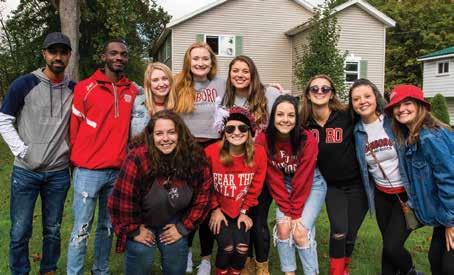
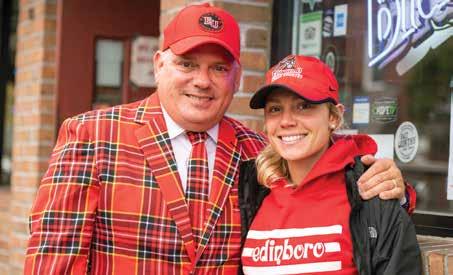
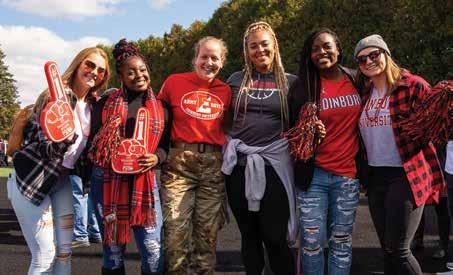
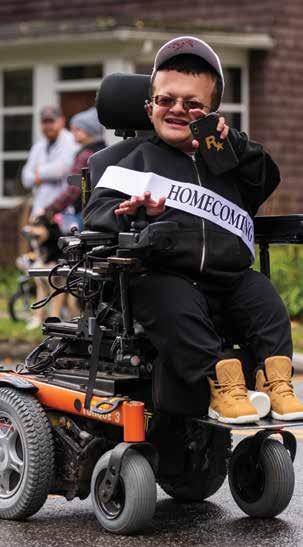






After months of construction and much anticipation, the Boro Pit – a unique outdoor venue located near the rear entrance of Van Houten Dining Hall – was completed in August. Many students, faculty, staff, alumni and community members have already checked out the space, which features a small stage and outdoor speakers for performances, a meditation garden, a fire pit, outdoor games and hammocks.
The project was made possible by privately funded donations and a generous gift from Edinboro University’s Student Government Association. Next time you’re on campus, be sure to stop by and enjoy a game of cornhole.
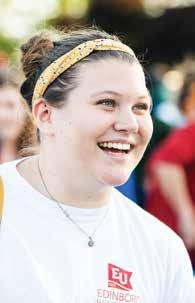













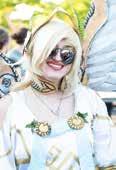


 By Kristin Brockett
By Kristin Brockett
Children who attend elementary schools in high-poverty communities have fewer opportunities to experience hands-on STEM (science, technology, engineering and math) activities, according to the Education Commission of the States. Based on that statistic, it comes as no surprise that a 2018 study by the Equality of Opportunity Project revealed individuals who grew up in wealthy households are 10 times more likely to become inventors than those from low-income households.
Throughout the U.S., the demand for STEM-trained workers continues to grow. Yet more than half of public schools in the nation report difficulties recruiting and retaining qualified STEM educators. The commonwealth of Pennsylvania is no exception.

According to the Pennsylvania Department of Education, the number of undergraduate education majors in the state has declined 55% since 1996, while the number of newly issued Pennsylvania Instructional I teaching certificates has dropped by 71% since 2009-2010 – from 15,247 to 4,412 in 2016-2017.
In response to this critical need, Edinboro University has received a $1.2 million National Science Foundation (NSF) Robert Noyce Teaching Scholarship Program grant to help address the nationwide shortage of secondary STEM teachers.
The funds will be used to increase the number of math and science educators prepared to teach in high-need urban and rural school districts.
“This funding is a testament to Edinboro University’s strength in the STEM fields, as well as our top-notch teacher preparation program,” said Dr. James Fisher, associate provost.
“Edinboro has a long history of producing graduates who go on to make the world a better place. This award will enable us to continue that legacy by preparing teachers who go where the need is greatest.”
Over the next five years, the grant will provide $17,150 scholarships to highachieving undergraduate STEM scholars during their fourth and fifth years at the University. The 4+1 model will allow students to earn a Bachelor of Science degree in chemistry, mathematics, physics or biology and a Pennsylvania secondary teaching certification.

Additionally, 12 graduates who already hold a Bachelor of Science degree in a STEM field will each receive a $30,000 stipend to earn a teaching certification.
The Edinboro University Noyce Teaching Scholarship will be jointly administered by expert faculty in the College of Science and Health Professions and the School of Education.
“As the demand for qualified teachers continues to grow, Edinboro University remains committed to the support and success of regional, rural and urban school districts,” said Dr. Erinn Lake, dean of Edinboro’s nationally recognized School of Education. “This funding will produce life-changing pathways for future leaders in the field of secondary STEM education.”
For more information about enrolling in Edinboro University’s nationally recognized degree programs or to learn more about the National Science Foundation Robert Noyce Teaching Scholarship Program, email ENTS@edinboro.edu
ADD YOUR NAME TO THE ART 100 DONOR WALL
Plans are underway for the creation of a 2,700-square-foot contemporary exhibition space on the first floor of Baron-Forness Library. The bold gallery will be a highly visible capital improvement, expanding art space on campus and filling a cultural gap in the Edinboro community.

Located in the heart of campus, the gallery will be a dynamic teaching and learning resource for faculty and students, where best practices for exhibition and curatorial development, experimentation and innovation take place. Exhibitions will be presented to expose the University and wider community to a rotating schedule of work by students, faculty and alumni of the University and to push conversations across disciplines and departments.
To add your name to the ART 100 Donor Wall or for more information, contact the Advancement Office at (814) 732-2992.
